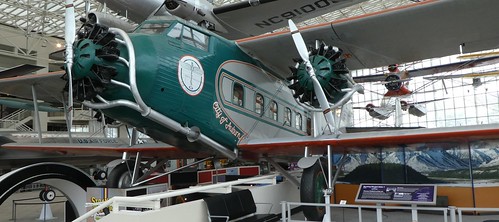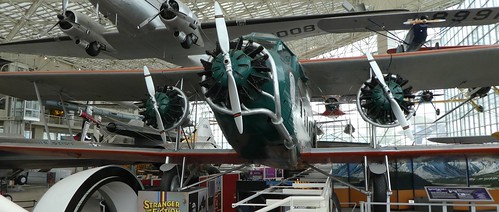In 1910, lumber baron William Boeing attended an the Los Angeles International Air Meet and develops a passion for airplanes. In 1915, Boeing attended an airshow and had his first plane ride in a Curtiss seaplane. The following year, Boeing incorporates the Pacific Aero Products Co. This marks the birth of the Boeing Company. The Museum of Flight in Seattle, Washington, displays several early Boeing airplanes in the Great Hall.
Boeing Model 1 (replica)
Boeing’s first airplane, the B&W (for Boeing and George Conrad Westervelt) first flew on June 15, 1916, with William Boeing as its pilot. Boeing had hoped to sell the plane to the U.S. Navy, but it was turned down. The plane was shipped to New Zealand where it was used for airmail and military flights. The replica on display in the Museum was built for the Boeing Company’s 50th anniversary.

The 1916 B&W had a cruising speed of 67 mph, a top speed of 75 mph, and a range of 320 miles. It was powered by a 125 hp Hall-Scott A-5.
According to the Museum:
“The B&W was the very first Boeing aircraft, designed and built by William E. Boeing and Conrad Westervelt, hence the "B&W" initials. Boeing, then a prominent timber man, and Westervelt, a Navy engineer, first met at Seattle's University Club. They bonded over their shared interests and backgrounds; both men liked boating and playing bridge, both had studied engineering, and both had a fascination with the dawning field of aviation. Their initial flights in a Martin seaplane convinced the two men they could develop a better airplane.”



Boeing Model 40B (reproduction)
The Boeing Model 40 was designed to replace the de Havilland DH-4 mail planes used by the U.S. Post Office. The prototype first flew in 1925. About 80 Model 40s were built.
The prototype of the Model 40 used a mixed wood-and-steel fuselage. The production models used welded steel tubing in the fuselage.
The 1928 Model 40B had a cruising speed of 125 mph, a top speed of 132 mph, a range of 535 miles, and a service ceiling of 15,199 feet. It was powered by a 525 hp Pratt & Whitney “Hornet” engine.
 Notice that the pilot has an open-air cockpit while the plane’s two passengers are inside.
Notice that the pilot has an open-air cockpit while the plane’s two passengers are inside.








Boeing Model 80A-1
First flown in 1928, the Boeing Model 80 was a passenger aircraft. The Model 80 held 12 passengers and the Model 80A held 18 passengers.

According to the display:
“The 80A had a heated cabin, leather seats, individual reading lights and lavatory with hot and cold running water. Although the 80 had a luxurious interior, flying was tough by today’s standards. The plane bumped along at low altitudes while engine noise made conversation almost impossible. And despite heaters, the cabin was very cold in the winter and scorching hot in summer months.”


The Model 80A-1 had a cruising speed of 125 mph, a top speed of 138 mph, a range of 460 miles, and a service ceiling of 14,000 feet.




Boeing Model 100
During the 1920s, the military still wanted the World War I-style biplanes even though many of the civil airplanes of this period were monoplanes. The 1928 Boeing Model 100 was one of the fighter planes developed between the wars.

The Boeing Model 100 had a cruising speed of 169 mph, a top speed of 169 mph, a range of 520 miles, and a service ceiling of 26,900 feet. It was powered by a 450 hp Pratt & Whitney R-13408 Wasp engine. It carried a .50 caliber machine gun, a .30 caliber machine gun, and a 500-pound bomb.




More airplane photo tours
Museum of Flight: The Boeing 747 Prototype (photo diary)
Museum of Flight: The First Fighter Plane (photo diary)
WAAAM: Early Airplanes (Photo Diary)
Evergreen Aviation: Biplanes (photo diary)
Stonehenge Air Museum: Biplanes (Photo Diary)
Yanks Air Museum: Biplanes (Photo Diary)
Planes of Fame: Pre-WWII Fighters (Photo Diary)
Historic Flight: Biplanes (photo diary)


